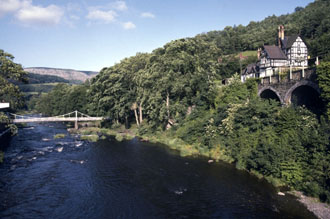地处威尔士和英格兰交界边境上的兰戈伦小镇,安逸地躺在Dyffryn Dyfrdwy (迪伊山谷)的怀抱中,周围青山屹立。14世纪的兰戈伦大桥是个名副其实的奇观,因为正在此时,桥的这头直到那头都挤满了舞者歌手、音乐家。享誉世界的男高音歌唱家帕瓦罗蒂都曾“慕名而来”……
 The little town of Llangollen (the Church of St. Collen) is nestled snugly in the Dee Valley (Dyffryn Dyfrdwy) among high green hills. Whilst near the border with England, the town has managed to retain much of its Welsh character, but for one week each July, the visitor might be excused for thinking he is not in Wales at all. The destination, 14th century Llangollen Bridge is truly a wonder, not to be missed, for at this time, from one end to the other it will be crowded with dancers, singers, musicians and merrymakers (with the requisite numbers of tourists, of course), from doz
The little town of Llangollen (the Church of St. Collen) is nestled snugly in the Dee Valley (Dyffryn Dyfrdwy) among high green hills. Whilst near the border with England, the town has managed to retain much of its Welsh character, but for one week each July, the visitor might be excused for thinking he is not in Wales at all. The destination, 14th century Llangollen Bridge is truly a wonder, not to be missed, for at this time, from one end to the other it will be crowded with dancers, singers, musicians and merrymakers (with the requisite numbers of tourists, of course), from doz
ens of different nations, resplendent in their national costumes.
A few hundred yards down the street from the bridge (built in 1347) a huge pavilion houses the annual competitions for choirs, and soloists, folk singers, dancers and musicians. This is the Llangollen International Musical Eisteddfod, founded in 1947 after the destruction of World War II with its shocking waste of life and disruption of much that had been held dear for so long.
Not long after the War had finally ended, a brilliant idea came to the mind of an official of the British Council, Welshman Harold Tudor of Coedpoeth (a few miles from Llangollen). Harold conceived the idea of an international folk festival, conducted very much along the lines of the Welsh National Eisteddfod, but open to competitors from all parts of the world. He enlisted the support of the music organizer of the National, W.S. Gwynn Williams, who immediately welcomed the idea, especially as it would allow the people of Wales to contribute in their own unique manner to the healing of the terrible scars left by the War. And so it came to be that the first festival took duly took place in the summer of 1947 on the banks of the Dee, under the great hill crowned by the ancient Welsh castle of Dinas Bran.
The actual site chosen for the new festival was in a broad grassy space between the banks of the River Dee and the Llangollen Canal. Fourteen different nationalities were represented, filling the streets of the drab, postwar town with colour and spectacle but above all, with glorious sound. It has been held each year since, attracting many thousands of spectators and hundreds of competitors, whose colourful native costumes and delightful singing and dancing fill the streets for one whole week, transforming a little Welsh town into a miniature universe. In the pavilion, choirs from places as diverse as Ukraine, Morocco and Argentina meet in friendly competition, getting together afterwards to celebrate their wins and losses in local pubs.
In recent years, the competitions have been augmented by "Choir of the Year" and "Singer of the Year" contests. The Choir of the world competition is open to male, female and mixed choirs, attracting performers of a very high standard. One of the competitors was the great tenor Luciano Pavarotti, who came with his father to sing in a choir from Italy in the early years of the festival and who returned to give a goodwill concert in 1995. Llangollen Bridge may be listed as one of the seven wonders of Wales, but it is the International Eisteddfod with its motto: Byd gwyn fydd byd a gano; gwardiadd fydd ei gerddi fo (Blessed is a world that sings; gentle are its songs) that is the true wonder.